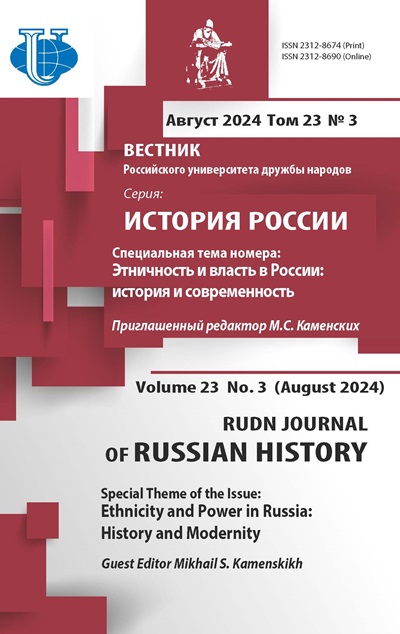Идея «Большой Европы» во внешней политике России: история и современность
- Авторы: Цвык А.В., Курылев К.П.1
-
Учреждения:
- Российский университет дружбы народов
- Выпуск: Том 19, № 2 (2020): НАРОДЫ СССР В ГОДЫ ВЕЛИКОЙ ОТЕЧЕСТВЕННОЙ ВОЙНЫ: К 75‐ЛЕТИЮ ПОБЕДЫ
- Страницы: 438-447
- Раздел: МЕЖДУНАРОДНЫЕ ОТНОШЕНИЯ
- URL: https://journals.rudn.ru/russian-history/article/view/23782
- DOI: https://doi.org/10.22363/2312-8674-2020-19-2-438-447
Цитировать
Полный текст
Аннотация
Развитие российского государства исторически сопровождалось поиском национально-цивилизационной идентичности, что проецировалось на его внешнюю политику. В конце XX - начале XXI в. Россия обратилась к идее сближения с европейскими странами и выдвинула концепцию «Большой Европы» как проект создания единого общеевропейского экономического, политического гуманитарного пространства. Реализация проекта «Большой Европы» стала одним из главных направлений российской внешней политики конца XX - начала XXI в. Однако с начала 2000-х гг. международная обстановка значительно изменилась. После событий 2014 г. на Украине и последующих санкций со стороны ЕС отношения между Россией и Евросоюзом оказались в состоянии глубокого кризиса, что значительно осложнило осуществление идеи о единой и неделимой «Большой Европе». В данной статье авторы прослеживают историю возникновения и развития идеи «Большой Европы», выявляют проблемы ее реализации в новом формате взаимодействия между Евразийским экономическим союзом и Европейским союзом. Авторы приходят к выводу, что эффективное взаимодействие между евразийской и европейской интеграциями может придать новый импульс идее «Большой Европы» только в случае преодоления политического барьера в отношениях между ЕС и Россией.
Ключевые слова
Об авторах
Анатолий Владимирович Цвык
Автор, ответственный за переписку.
Email: a.tsvyk91@mail.ru
Неаффилированный исследователь; кандидат исторических наук
г. Москва, РоссияКонстантин Петрович Курылев
Российский университет дружбы народов
Email: kurylev-kp@rudn.ru
доктор исторических наук, профессор кафедры теории и истории международных отношений
117198, Россия, Москва, ул. Миклухо-Маклая, 6Список литературы
- Бусыгина И.М. Основы Большой Европы. РСМД. М.: Спецкнига, 2014. 350 с.
- Виноградов А.В. Россия в Евразии: между Китаем и Западом. Идентичность, идеология и геополитика // Контуры глобальных трансформаций: политика, экономика, право. 2019. Т. 12. № 2. С. 228-246.
- Гурова И. Восточное партнерство: торговая интеграция “целевых” стран Евросоюза // Мировая экономика и международные отношения. 2018. Т. 62. № 3. С. 86-97.
- Громыко Ал.А. Большая Европа. Идеи, реальность, перспективы. М.: Весь Мир; Ин-т Европы РАН, 2014. 704 с.
- Заславская Н.Г. Проблемы взаимодействия ЕАЭС и ЕС // Управленческое консультирование. 2017. № 11. С. 38-39.
- Ильин Е.Ю. Концепция Большой Европы от Лиссабона до Владивостока: проблемы и перспективы // Вестник МГИМО-Университета. 2015. № 2. С. 77-85.
- Кондратьева Н. Отношения ЕС-ЕАЭС: особенности современного этапа // Современная Европа. 2018. № 3. С. 60-70.
- Кузнецов А. Переосмысление концепции Большой Европы в связи с украинским кризисом // Международные отношения. 2014. № 12. С. 6-17.
- Лукин А., Новиков Д. «От Большой Европы к Большой Евразии: что приносит миру фундаментальный геополитический сдвиг». Восток // Афро-азиатские общества: история и современность. 2018. № 5. С. 60-76.
- Цвык А.В. «Большая Европа» или «Большая Евразия»? В поисках новых идей для евразийской интеграции» // Вестник Российского университета дружбы народов. Серия: Социология. 2018. Т. 18. № 2. С. 262-270.
- Arbatova N. Cooperation or Integration? Russia and Greater Europe // Osteuropa. 2003. T. 53. № 9. С. 1492-1500.
- Hopf T. Understandings of Russian Foreign Policy. Pennsylvania: Pennsylvania State University Press, 1999. 294 p.
- Mackinder H.J. The Geographical Pivot of History // The Geographical Journal. 1904. Vol. 23. № 4. P. 421-437.
- Sakwa R. Looking for a Greater Europe: From Mutual Dependence to an International Regime // Communist and Post-Communist Studies. 2012. Vol. 45. № 3-4. P. 315-325.
- Taras R. Russian Identity in International Relations: Images, Perceptions, Misperceptions. London: Routledge, 2013. 155 p.
















